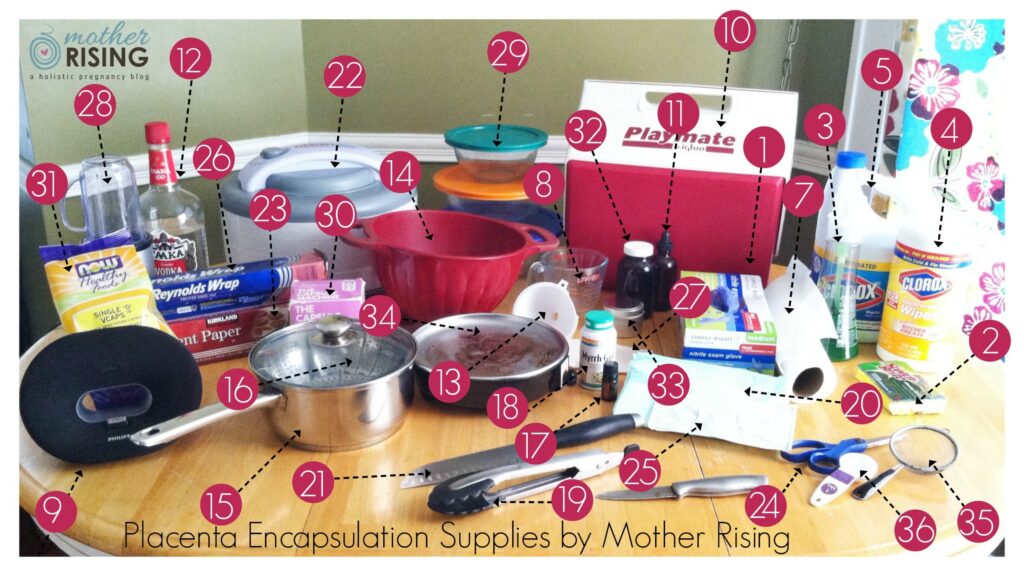An excellent placenta dehydrator is critical for encapsulating placentas correctly. It needs to be able to regulate the temperature down to the degree, be inexpensive, have a top mounted fan, and be easy to clean and sanitize.
Why Placenta Pills?
The biggest reason new parents look into eating placenta during the postpartum period is a natural method to avoid postpartum mood disorders and the second is to increase milk supply. However, nobody wants to actually eat a placenta like you would food, which is why placenta pills filled with dehydrated placenta into a fine powder is the next best thing.
Best Placenta Dehydrator for Placenta Encapsulation
I have been encapsulating placentas since 2010 and have always had great success with the Nesco Snackmaster Pro dehydrator. In all these years, I’ve only had to replace the dehydrator once, despite using it for 12-18 hours for each placenta. I’ve love this dehydrator and consider it the foundation of my placenta encapsulation supplies.
The best dehydrator for placenta encapsulation is one where you can regulate the temperature and that has a top mounted fan. I use 160 degrees for the placenta, and a lower temperature to dehydrate capsules before placing them in the capsule machine. It's important to use dehydrator with a top mounted fan for placenta encapsulation because the alternative, an enclosed fan dehydrator, cannot be cleaned and sanitized properly.
What to Look for in a Placenta Dehydrator
The following characteristics make a good dehydrator for the placenta encapsulation process.
Temperature Regulation
First, it is extremely important to have a placenta dehydrator that can adjust the temperature to a specific temperature. The traditional chinese method encapsulates placentas at 160 degrees after steaming, but some go as low as 115 degrees for the raw method, which means a “high, medium, or low” temperature nob is insufficient. When purchasing a dehydrator for placenta encapsulation make sure to find one with a temperature dial.
Inexpensive
Dehydrators can be expensive, but a dehydrator for placenta encapsulation doesn’t need to be. My favorite dehydrator typically runs around $75, which is very reasonable. The cost of placenta encapsulation runs around $250-$350, so for those considering DIY placenta encapsulation to save on cost will be happy they can get a solid dehydrator for 20% of the price of hiring someone to do it… and they get to keep the dehydrator!
Top Mounted Fan
Find a dehydrator like the Nesco Snackmaster with a top mounted fan, as those are easily cleaned and sanitized. Each tray can be fully submerged in soapy water and a bleach solution without any harm to the product. The top of the dehydrator can be lightly sprayed with a bleach solution and Clorox wipe for cleaning and sanitation. Easy!
Easy to Clean and Sanitize
If making placenta capsules as a business, it’s critical to have a dehydrator that can be cleaned and sanitized easily. Dehydrators that operate like ovens with a door on hinges won’t work for placenta encapsulation because the whole machine would need to be able to be taken apart to get properly cleaned. Avoid a fiasco and make sure you purchase a top mounted fan, and easily cleanable dehydrator.
If you’re looking to encapsulate your own placenta after birth, the ability to sanitize the dehydrator isn’t as important.
Time to Dehydrate
The amount of time the placenta is on the dehydrator
Placenta Dehydrator + Placenta Encapsulation Supplies
If you’re looking into encapsulating a placenta, check out my list of placenta encapsulation supplies for cleaning and setup, preparing the placenta for dehydration, dehydration, and filling capsules with placenta powder. You’ll need more than a dehydrator, but you may have some things on hand like a cutting board, a steamer basket, and parchment paper.
Placenta encapsulators new to the business will find this list helpful to get to work. For those interested in DIY placenta encapsulation, you will also find it helpful as it gently walks through the entire encapsulation process, but you’ll likely only need the 6 piece placenta encapsulation kit.


